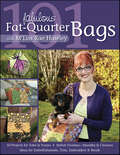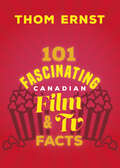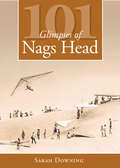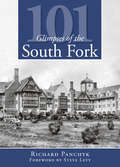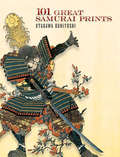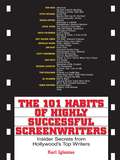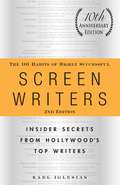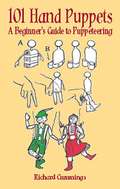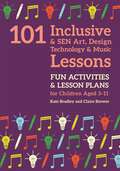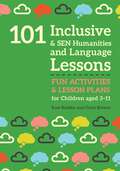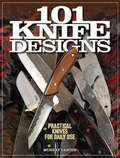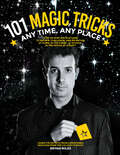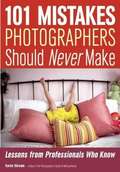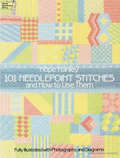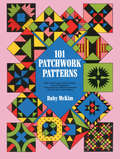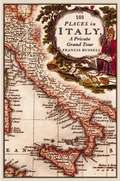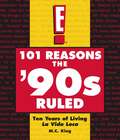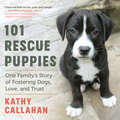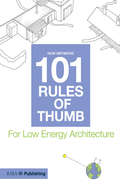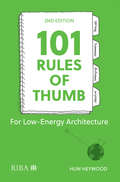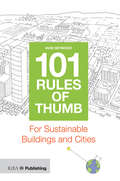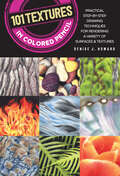- Table View
- List View
101 Fabulous Fat-Quarter Bags With M'Liss Rae Hawley
by M'Liss Rae HawleyMake Yourself a Brand New Bag! Carry everything with style in super-easy bags for every season, occasion, or outfit. 10 fat-quarter-friendly projects include small and large purses, totes, and zippered pouches. Huge idea gallery of 101 bags to inspire your own designer originals. In-depth chapter on handles and closures If “you can never have too many bags” is your motto, M’Liss Rae Hawley has just what you need: every kind of bag, from cute little children’s purses, to handy pouches that make packing for vacation a breeze, and elegant evening bags for hitting the town in style. Add your own personal touch with handles and embellishments: appliqué, quilting, embroidery, buttons, beads, ribbons, and trims.
101 Fascinating Canadian Film and TV Facts (101 Fascinating Facts #3)
by Thom Ernst101 lesser-known stories to delight Canadian cinema and television fans. Do you know who was in the first on-screen nude scene in a Canadian feature film? Or which David Cronenberg film was raided for obscenity? Why was Oliver Reed arrested while shooting The Brood ? Which iconic Canadian television series was syndicated in over fifty different countries? Which Canadian film critic wrote a full-page retraction after reconsidering a positive review he gave a film? And what role did Canada play in the creation of Dennis Hopper’s Easy Rider? With an eye for the unique and the absurd, 101 Fascinating Canadian Film & TV Facts, from one of Canada’s leading film critics, is a lively and humorous look at the best and the worst, the firsts and the lasts, and the groundbreaking truths behind Canada’s film and television industry.
101 Glimpses of Nags Head
by Sarah DowningNags Head boasts a plethora of natural wonders. From an ecologically unique maritime forest to breathtaking coastal dunes, the dynamics of the area corroborate the sentiment Thomas Nixon expressed in his 1964 classic. Indeed, as early as the 1830s, merchants and planters from the Albemarle region of North Carolina and Southside Virginia brought their families to Nags Head via boat to exchange the oppressive inland summer heat for cool ocean breezes. In this striking photographic collection, Downing illustrates why this scenic spot on the Outer Banks has been beloved for generations by sun-seekers, sightseers and surfers alike.
101 Glimpses of the South Fork (Vintage Images)
by Richard PanchykLong Island�s South Fork�famous for the Hamptons�is now one of the hottest summer destinations for the wealthiest and most famous Americans. But it wasn�t always so�.When European explorers arrived on Long Island�s southeastern-most shores in the seventeenth century, they shared the land with the Montauket and Shinnecock Indians. The South Fork remained relatively rural until the railroad arrived in the 1870s. In this pictorial history, Richard Panchyk surveys how dramatically the landscape has changed, from the famous Montauk Lighthouse and iconic windmills to the sprawling mansions and opulent hotels, and highlights some of the notable figures who graced these shores, including New York politicians and a plethora of artists and celebrities. Showcasing the South Fork�s famous faces and places, Panchyk reveals this coastal community�s bygone era.
101 Great Samurai Prints
by John Grafton Utagawa KuniyoshiOne of the last great names in the Japanese ukiyo-e style, Utagawa Kuniyoshi was an undisputed master of the warrior woodblock print. Born in Tokyo in 1797, his talent became evident by the tender age of 12, when he became an apprentice to a famous print master. Starting out with vivid illustrations of cultural icons--including Kabuki actors and Japanese heroes--he moved on to a unique treatment of warrior prints, incorporating elements of dreams, omens, and daring feats that characterized his distinctive style. These dramatic eighteenth-century illustrations represent the pinnacle of his craft. One hundred and one full-color portraits of legendary samurai pulse with movement, passion, and remarkably fine detail. A must for collectors of Japanese art and a perfect first work for those who want to start their own collection, it includes brief captions and a new introduction.
The 101 Habits Of Highly Successful Screenwriters
by Karl IglesiasInsider Secrets from Hollywood's Top WritersThis book not only shows how to be a screenwriter, but what it's actually like to be one. An inspiration to all would-be screenwriters, this book is about living the screenwriter's life -- the habits, writing environments, creative processes, daily passions, and obsessions. In The 101 Habits of Highly Successful Screenwriters, author Karl Iglesias has interviewed 14 top contemporary Hollywood screenwriters who offer their experience, insight, and advice to aspiring screenwriters everywhere.
The 101 Habits Of Highly Successful Screenwriters: Insider's Secrets from Hollywood's Top Writers
by Karl IglesiasInsider Secrets from Hollywood’s Top WritersThis book not only shows how to be a screenwriter, but what it's actually like to be one. An inspiration to all would-be screenwriters, this book is about living the screenwriter's life -- the habits, writing environments, creative processes, daily passions, and obsessions.In The 101 Habits of Highly Successful Screenwriters, author Karl Iglesias has interviewed 14 top contemporary Hollywood screenwriters who offer their experience, insight, and advice to aspiring screenwriters everywhere.
The 101 Habits of Highly Successful Screenwriters
by Karl IglesiasYou can struggle for years to get a foot in the door with Hollywood producers--or you can take a page from the book that offers proven advice from twenty-one of the industry's best and brightest! In this tenth anniversary edition, The 101 Habits of Highly Successful Screenwriters, 2nd Edition peers into the lives and workspaces of screenwriting greats--including Terry Rossio (the Pirates of the Caribbean franchise), Aline Brosh McKenna (Morning Glory), Bill Marsilii (Deja Vu), Derek Haas and Michael Brandt (Wanted), and Tony Gilroy (the Bourne franchise). You will learn best practices to fire up your writing process and your career, such as: Be Comfortable with Solitude Commit to a Career, Not Just One Screenplay Be Aware of Your Muse's Favorite Activities Write Terrible First Drafts Don't Work for Free Write No Matter What This indispensable handbook will help you hone your craft by living, breathing, and scripting the life you want!
The 101 Habits of Highly Successful Screenwriters, 10th Anniversary Edition
by Karl IglesiasYou can struggle for years to get a foot in the door with Hollywood producers--or you can take a page from the book that offers proven advice from twenty-one of the industry's best and brightest! In this tenth anniversary edition, The 101 Habits of Highly Successful Screenwriters, 2nd Edition peers into the lives and workspaces of screenwriting greats--including Terry Rossio (the Pirates of the Caribbean franchise), Aline Brosh McKenna (Morning Glory), Bill Marsilii (Deja Vu), Derek Haas and Michael Brandt (Wanted), and Tony Gilroy (the Bourne franchise). You will learn best practices to fire up your writing process and your career, such as: Be Comfortable with Solitude Commit to a Career, Not Just One Screenplay Be Aware of Your Muse's Favorite Activities Write Terrible First Drafts Don't Work for Free Write No Matter What This indispensable handbook will help you hone your craft by living, breathing, and scripting the life you want!
The 101 Habits of Highly Successful Screenwriters, 10th Anniversary Edition: Insider Secrets from Hollywood's Top Writers
by Karl IglesiasYou can struggle for years to get a foot in the door with Hollywood producers--or you can take a page from the book that offers proven advice from twenty-one of the industry's best and brightest!In this tenth anniversary edition, The 101 Habits of Highly Successful Screenwriters, 2nd Edition peers into the lives and workspaces of screenwriting greats--including Terry Rossio (the Pirates of the Caribbean franchise), Aline Brosh McKenna (Morning Glory), Bill Marsilii (Deja Vu), Derek Haas and Michael Brandt (Wanted), and Tony Gilroy (the Bourne franchise).You will learn best practices to fire up your writing process and your career, such as:Be Comfortable with SolitudeCommit to a Career, Not Just One ScreenplayBe Aware of Your Muse's Favorite ActivitiesWrite Terrible First DraftsDon't Work for FreeWrite No Matter What This indispensable handbook will help you hone your craft by living, breathing, and scripting the life you want!
101 Hand Puppets: A Beginner's Guide to Puppeteering
by Richard CummingsThis entertaining how-to book, with its simple, step-by-step instructions, makes it easy to create every kind of puppet imaginable — from such handkerchief varieties as Spook-a-boo the Ghost (made with a simple twist of the wrist) for beginners and Flak J. Frog for performers at the intermediate level, to such special figures as a Box of Demons for advanced puppeteers who want to expand their cast of characters.A host of charming little personalities lead the way, among them such "instant" puppets as Bagdad, the paper bag gremlin; the Matchbox Monster, Spoonerella, and Carrie Carrot; "rainy day" puppets that include Robert Robot, Little Miss Muffet, Perky Pup, and Gordo the Wizard; professional puppets such as Pat the Policeman, Bird McDermitt, Klondike Kitty, Honk Kong, the Ape; and dozens of other delightful figures.Scripts for three plays as well as simple designs for stages and props are included, allowing performers of all ages to put on their own shows and have fun bringing their creations to life.
101 Inclusive and SEN Art, Design Technology and Music Lessons: Fun Activities and Lesson Plans for Children Aged 3 – 11
by Kate Bradley Claire BrewerCreate an inclusive classroom for all with these fun and accessible activities for Art, Design Technology and Music lessons. Each lesson is tailored for children working below National Curriculum levels and includes a learning objective, the resources needed, the main activity, a plenary and a consolidation activity to help support children's understanding. Activities such as 'Peg Painting' and 'Build my Car' build visual, auditory, social communication and fine motor skills and support self-esteem and mental wellbeing.The 101 creative activities in this book aim to support the ever-increasing demands on teachers to meet the needs of the growing number of SEN learners in mainstream settings. It also offers practical lesson plans that have been specifically designed to promote fine and gross motor skills and utilise lots of visual stimulus.
101 Inclusive and SEN Humanities and Language Lessons: Fun Activities and Lesson Plans for Children Aged 3 - 11
by Kate Bradley Claire BrewerCreate an inclusive classroom for all with this resource. From Sensory Box Fire Station to Victorian Me, this book is overflowing with ideas for engaging and accessible Geography, History and Language lessons. Each lesson is tailored for children working below National Curriculum levels and includes a learning objective, the resources needed, the main activity, a plenary and a consolidation activity to help support children's understanding.The activities in this book have been specifically designed to promote fine and gross motor skills and utilise lots of visual stimulus, which is important for working with children with SEN. This straightforward and practical book offers you 101 creative classroom activities for teaching Humanities and Languages to pupils who are working below national curriculum levels, as well as mapping the range of additional skills they will acquire.
101 Knife Designs
by Murray CarterGreat designs, great knives! In 101 Knife Designs, join master smith Murray Carter as he reveals the successful traits of knife designs that have lasted throughout history. Knife enthusiasts and knife makers alike will learn to: Identify common traits in great knives. Understand how to apply them to new knife design. For the first time ever, Carter shares details of his personal collection of successful patterns--created and perfected over decades of designing and making knives. Dazzling, full-color images of completed knives--from renowned photographer Hiro Soga--provide inspiration and direction as you apply these principles to create your own custom knife designs. With 101 Knife Designs, you, too, can make practical knives that will become cherished keepsakes.
101 Magic Tricks: Any Time, Any Place
by Bryan MilesAstonish and amaze with step-by-step instructions for 101 simple, mind-blowing magic tricks—no fancy equipment needed!Ladies and gentlemen, boys and girls. Step right up and try not one, not two, not three, but 101 Magic Tricks! Delight kids and adults alike with easy-to-master tricks and illusions.Learn classic sleight-of-hand techniques that are simple enough for any apprentice to grasp. Conquer magical ruses that require no special equipment, and are explained with simple step-by-step instructions. Award-winning magician and mentalist Bryan Miles will guide you through The Foundations of Magic including: The Hand, The Deck of Cards, Mechanic’s Grip and Biddle Grip, Classic Two-Handed Spread, and Cutting the Cards.
101 Mistakes Photographers Should Never Make: Lessons from Professionals Who Know
by Karen DorameKaren Dorame presents hard-won tips and techniques that allow you to smooth out the bumps in the road toward a career in professional photography. She covers equipment selection and use, light source options and lighting setups using natural light and studio lighting, and shows you how to get the most out of your store-bought backgrounds and posing aids and "found” backgrounds and posing implements on location. You’ll find sage advice on avoiding posing mistakes for individuals and groups. Of course, Dorame also offers pointers on avoiding common post-production traps, saving you time, frustration, and compromised image quality. The balance of the book details problems that aspiring professionals often face in handling the business side of photography. You’ll learn what not to do when it comes to booking sessions, conceptualizing shoots, and more. Finally, you’ll learn how to weather the changes and stay at the top in this exciting, demanding field.
101 Needlepoint Stitches and How to Use Them: Fully Illustrated with Photographs and Diagrams (Dover Embroidery, Needlepoint)
by Hope HanleyTired of doing the same basic stitches over and over again? Noted designer Hope Hanley can help you bring new excitement and beauty to your needlepoint in more than a hundred different ways. In this practical, extremely well-organized guide she presents a treasury of 101 decorative stitches, with an easy-to-read chart and an actual-size photograph for each one.Only stitches which adequately cover the canvas have been included in this versatile collection. In Tapestry no warp threads are allowed to show through, so why let canvas show in needlepoint? Enhance and individualize your needlepoint projects with expert advice on a host of exquisite stitches: rep stitch; fancy cross stitch; Renaissance stitch; cross stitch; Herringbone stitch; shaded stripe stitch; double stitch; mosaic stitch; French stitch; Greek stitch; velvet stitch; closed cat stitch; and scores more.The author explains precisely where and how to make best use of each stitch (as a filling stitch in small areas, as a background or a grounding pattern), and tells whether each is slow or quick to work up and whether it's best on mono or two-thread canvas. No stitch combinations have been included, just the fundamental stitch. Think up your own combinations -- there are hundreds of them!Whether you're a beginner, intermediate, or advanced needleworker, give your needlepoint a vibrant new look with this modestly priced, indispensable reference work.
101 Patchwork Patterns
by Ruby S. MckimThis is one of the finest of all the available books on the making of patchwork quilts. The author is recognized as having been one of our country's leading authorities on this venerable art, and in this book she divulges many a secret that will assist you in making quilts of the highest quality.The book contains over 100 patchwork patterns, with complete instructions for cutting and sewing. All conceivable sorts of designs are diagrammed and carefully described: flower designs, rainbows designs, Irish chains, fish and bird and leaf designs. The book shows you, step by step, all the details of making each kind of quilt: it covers choice of pattern, piece vs. patch quilting, simple and complex quilts, choice of quilt materials, interlining materials, lining and thread materials, cutting and piecing, the applique process, various methods of setting together, quilt sizes, borders, scallops, flounces, valances, straight line and close shell quilting, methods of stamping, perforated quilting patterns, quilting the quilt, putting into frames, quilting in a small space, embroidery quilts, and many other topics.The book is written in an entertaining manner. The author weaves a great deal of rosy humor into the lining of her instructions, as well as some interesting facts about the history of quilting, quilt materials, patterns, and some really choice folklore about the origin of the highly ingenious names of the patterns: "Monkey Wrench," "Road to California," "Lafayette Orange Peel," "Drunkard's Path," and "Crossed Canoes," to name a few.The book is not technical in any sense of the word. You can use it to make beautiful quilts provided only that you know the fundamentals of sewing.
101 Places in Italy: A Private Grand Tour
by Francis Russell"The author has achieved the near impossible...a must-squeeze-into-hand-baggage or the back pack."--House and Garden"A minor classic."--The Times Literary SupplementThis personal, and wonderfully well-informed, selection of the most rewarding towns, cities, villages, and individual monuments in Italy is the definitive guidebook for the discerning traveler. The author has been visiting Italy, for study, for work, and for pleasure, for over fifty years, and is the perfect companion for those who want to know about more than the obvious attractions.As well as comprehensively covering the finest sights in the major tourist centers of Rome, Florence, Venice, and elsewhere, Francis Russell discusses and describes the neglected, or little-known, masterpieces that are still to be found the length and breadth of the Italian peninsula. In a book that will educate and astonish the expert as surely as it will guide and inform the first-time visitor, the author chooses and explores palaces and gardens, city squares and lonely churches, frescoes and altarpieces, great museums and tiny ruins that together provide a richly textured portrait of a country where the history and patterns of civilization lie more thickly than anywhere else on earth.This book will immeasurably enhance and enrich the visitor's experience of the most visited country in the world, by virtue of its sensitivity, its wisdom, and its deep knowledge, and by means of its vivid, eloquent, and entertaining exposition.Francis Russell was educated at Oxford. He is deputy chairman of Christies and specializes in Old Master and Italian paintings.
101 Reasons the '90s Ruled: Ten Years of Living La Vida Loca
by M. C. KingThe '90s were so money! Sit back and relive ten of the best years of your so-called life... Presidential scandals, rap feuds, Baywatch -- the '90s had it all. It was the decade during which we first visited 90210 and had coffee with our Friends. We got on the Web and started to Google and lol. We learned that a show about nothing can definitely be something, and that men and women hail from different planets! (Who knew?) And for at least a second or two, we may have wondered whether the Blair Witch was real. The perfect companion to E!'s 101 Reasons the '90s Ruled miniseries, this book relives memorable moments from a momentous decade. Every page will make you say, "Dude, I totally remember that." Unless, of course, you are very, very young (or don't call people dude). Packed with cool photos and irreverent commentary, 101 Reasons the '90s Ruled is Absolutely Fabulous.
101 Rescue Puppies: One Family’s Story of Fostering Dogs, Love, and Trust
by Kathy CallahanOver the past decade, Kathy Callahan&’s family has taken in more than a hundred rescue puppies. This delightful photo-filled book features the wonderful stories that emerged as these foster pups were suddenly surrounded by a nurturing family complete with patient adult dogs and curious cats. With a gift for capturing the moment in both words and images, Callahan brings readers inside the poignant and ultimately uplifting work of fostering. This inspiring read is indeed about puppies, but it&’s also about family and human connection. It&’s about finding your own way — through that one special thing you can do to light a candle, instead of cursing the darkness.
101 Rules of Thumb for Low Energy Architecture
by Huw Heywood101 Rules of Thumb sets out the essential elements of low energy architecture in a fresh, intuitive way. In an area where ever-changing technology and complex legislation and can cloud the designer’s thought-processes, this book encourages the designer to think clearly and intuitively about the fundamentals of low energy buildings. With reliable, simple rules of thumb that will provide new ideas and refresh the designer’s palette, each page focuses on a single piece of advice or guidance along with a clear hand-drawn illustration, while there are also plenty of tips and more detailed information for those who wish to dig deeper. The emphasis is on passive low-energy principles, and the rules of thumb cover all the design fundamentals from site and location to orientation and form, peppered with some which will help the designer to think ‘outside the box’ about the design process itself.
101 Rules of Thumb for Low-Energy Architecture
by Huw HeywoodBuildings and construction are a major contributor to the climate and biodiversity emergency. They account for nearly 40% of energy-related carbon dioxide (CO2) emissions. It is more important than ever for architects to design responsibly and create low-carbon, low-energy buildings for a sustainable future. 101 Rules of Thumb sets out the essential elements of low-energy architecture in a fresh, intuitive way. Where ever-changing technology and complex legislation can cloud the designer’s thought-process, this book equips you with the fundamentals you need to minimise CO2 emissions, design for low-energy use and work with, not against, the forces of nature. With reliable, simple rules of thumb, each page focuses on a single piece of guidance along with a clear hand-drawn illustration. The emphasis is on passive low-energy principles, and the rules of thumb cover all the design fundamentals from site and location to orientation and form, peppered with ideas to help the designer think outside the box, drawing inspiration from traditional methods, photoperiodic plants, and the black-tailed prairie dog. An extended, fully updated narrative bibliography explores the sources in detail and provides a valuable springboard for further study. Applicable throughout the world in any climate region, 101 Rules of Thumb is a global primer to be dipped into at any time as a quick means of re-focusing on what’s important when designing a new or retrofitted low-energy building. The rules cover: Site and location Orientation and form The low-energy building envelope Carbon free heating, cooling and lighting Passive low-energy principles.
101 Rules of Thumb for Sustainable Buildings and Cities
by Huw HeywoodPeople across the world are becoming more aware of the need for the buildings and cities they live and work in to be sustainable, but the issue of how to be sustainable can seem a confusing and complex one. These rules of thumb provide universal guidelines for the sustainable design of both buildings and the urban realm. It’s a global primer and textbook for anyone interested in understanding sustainability in the built environment, an ideal starting point for students as well as an aide memoir for more experienced readers and practitioners interested in this field.
101 Textures in Colored Pencil: Practical Step-by-Step Drawing Techniques for Rendering a Variety of Surfaces & Textures (101 Textures Ser.)
by Denise J. HowardCapture the feel of your subject on paper. Learn every technique you’ll need to give your colored-pencil drawings realistic, palpable texture.Named One of the 54 Best Colored Pencil Drawing Books of All Time by BookAuthority*There has never been a better opportunity to master textures. Knowing how to make your surfaces and textures look real is one of the most challenging aspects of creating art in colored pencil, even for experienced artists. 101 Textures in Colored Pencil provides artists with step-by-step instructions for drawing a wide variety of the most common textures and surfaces, including sand, water, metals, foliage, wood, fabrics, stone, grass, hair, and many more.To get you started, this comprehensive guide opens with a review of tools and materials as well as basic skills, such as strokes, effects, and color mixing. Plus, the book is organized into sections based on subject matter, so you can easily find the specific texture you’re looking for. Just a sample of the textures you will learn to render:People: smooth skin; aged skin; straight, curly, and wavy hair; lipsAnimals & Insects: smooth, curly, and course canine fur; elephant skin; feather; fish scalesFabrics & Textiles: burlap, tweed, silk, velvet, leather, lace, sequinsGlass, Stone, Ceramics, Wood & Metal: porcelain, polished silver, hammered brass, peeling paintFood & Beverage: red wine, cut citrus fruit, coconut, peach, dark chocolateNature: smooth and rough bark, moss, river pebbles, still and rippled lake, clouds101 Textures in Colored Pencil includes all the textures you need to create realistic masterpieces in colored pencil.
